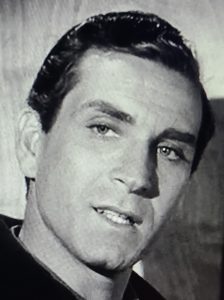
When I telephoned to interview actor Peter Mark Richman, I wasn’t particularly interested in him as a person. I considered him too name-recognizable (at least as “Mark Richman”), too handsome, too much of a leading man to be reckoned among the under-acknowledged character actors of Supporting TV Cast. I was far more interested in using him as a conduit to find backstories on such as:

or

or
 (Russell Collins, Barbara Baxley and Juanita Moore respectively) – all of whom appeared in productions alongside him – than I was in Richman himself. I was wrong, wrong, wrong on so many counts.
(Russell Collins, Barbara Baxley and Juanita Moore respectively) – all of whom appeared in productions alongside him – than I was in Richman himself. I was wrong, wrong, wrong on so many counts.
If they live in the profession long enough, most once well-known leading men and women will become under-recognized character actors. Time remolds or etches their handsome faces then rolls away backward like a camera on a dolly, leaving them appearing to grow smaller, in a thickening cinematic or videographic haze of dimming acknowledgement. Peter Mark Richman’s career began with stage and 1950s television and traversed through – and beyond – Three’s Company and Beverly Hills 90210. What I found in the Richman interview was a vibrant, productive, multi-talented, widely proficient, and life-loving man with his own episodic story.
* * *
When he answers the phone he seems, for a few extended seconds at the age of 89, to be uncertain of his own name or the fact that we had a pre-arranged appointment. He is teasing me. He follows the jest with a warm, hearty laugh and we’re off to the races.
Anything I did not ask him then I can, now, never ask him. Peter Mark Richman died in early 2021 – five years after the interview.
Perhaps I should have led off by inquiring where “Peter” came from. In a career spanning seven decades including movies, stage, and over 500 television guest appearances – along with the starring role in a short-lived yet guest star jam-packed NBC TV series – he was always billed as “Mark Richman” until, in the 1970s, “Peter” showed up affixed to his name. It did not come from his birth certificate: he was born Marvin Jack Richman. “I resisted ‘Peter’ for many years,” Richman tells me when I finally get around to asking about this. By then, it is probably too tedious to explain why “Peter” specifically, because he never made that clear. But it relates to a spiritual enlightenment that began when Richman and his wife became, as he put it, “opened to the contact,” in 1959.
Perhaps timing is always infused with destiny; the year of Richman’s first onscreen appearance, an episode of the TV series Suspense, was 1953 which was also the year he married actress Helen Richman. (Notably, Helen has worked primarily under her married name since her first onscreen credit, in a Playhouse 90 segment in 1958, rather than as Teddi Landess as she had previously appeared on the stage.) They journeyed together as a married couple for the rest of his life. “It’s a rarity in these parts,” Peter Mark remarks, referring, of course, to the lengths of marriages in Hollywood. By the time of his death, the couple had scored 67 years of wedded commitment which I’d say is “a rarity” in just about any parts.
His voice was still rich with a trained actor’s resonance as we touched on the myriad aspects of his life and career.
In my attempt to elicit his recollections of supporting actors with whom he had worked, I throw names at him. I try names from Cain’s Hundred, the drama series on which Richman starred in the leading role of Nicholas Cain. “I was a lawyer who worked for The Mob,” he explains, “and then I got fed up and tried to leave The Mob. They tried to kill me,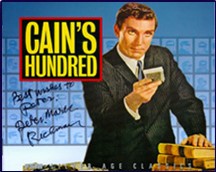 and they bumped off my fiancé; and I vowed to indict and prosecute 100 criminals.” He chuckles. “I only got to 30.” That is the number of episodes there were. While the series lasted a mere one season (1961 to 1962), a surprising percentage of the actors working in television at the time appeared in one or another segment of that show. Yet, the only guest star name I get to throw out specifically from Cain’s Hundred that evokes
and they bumped off my fiancé; and I vowed to indict and prosecute 100 criminals.” He chuckles. “I only got to 30.” That is the number of episodes there were. While the series lasted a mere one season (1961 to 1962), a surprising percentage of the actors working in television at the time appeared in one or another segment of that show. Yet, the only guest star name I get to throw out specifically from Cain’s Hundred that evokes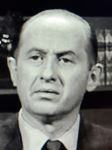 a strong and immediate response is Milton Selzer. “Oh yeah,” he seems delighted to recall, “Milt and I were old buddies. I worked with him many times.”
a strong and immediate response is Milton Selzer. “Oh yeah,” he seems delighted to recall, “Milt and I were old buddies. I worked with him many times.”
He also worked a few times with Elliot Silverstein, a director prominent in mid to late-20th century television, and I prod Richman to verify that Silverstein was a difficult artist to work with. “He was testy,” Peter Mark admits but he stresses that, “I don’t favor talking about anybody negatively.” After a moment of further consideration and with no additional prodding he slaps down the comment, “He was kind of a pain in the ass.”
He agrees that he and actress Hazel Court have onscreen chemistry in their Twilight Zone segment “The Fear” which has frequently aired in the
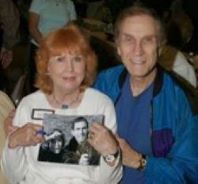
popular Syfy marathons. He describes her as, “a lovely girl.” “A lovely man,” is his description of actor/director Paul Henried who helmed the cast of a 1958 film, with the incredible title Girls on the Loose, in which Richman plays a police lieutenant. Rod Serling he depicts as, “a hell-of-a-guy and a hell-of-a-writer…Originality and the pursuit of ideas was Rod Serling’s,” here he searches for a word to summarize his tribute, coming up simply with, “habit.”
His whole demeanor melts when I bring up Lois Nettleton. A Play of the Week Christmas season installment in 1960 was what Richman had somewhere noted as one of his favorites of his own onscreen experiences. Titled Emmanuel, the teleplay starred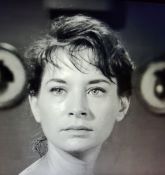 Peter Mark as Joseph and Nettleton – who passed away in 2008 at the age of 80 – as the Virgin Mary. Reflecting on Nettleton he says, “She was warm and lovely to look at, and she had a vibrancy in her eyes and manner, and I loved her.”
Peter Mark as Joseph and Nettleton – who passed away in 2008 at the age of 80 – as the Virgin Mary. Reflecting on Nettleton he says, “She was warm and lovely to look at, and she had a vibrancy in her eyes and manner, and I loved her.”
During these recollections, Richman leaves his phone three times to ask Helen to help him remember this or that; “My wife will refresh me,” he explains. Once, I am left on hold briefly while he takes a call from one of his sons who, it turns out, is coming from out-of-town to visit later that day. This close intertwining with a loving family was clearly giving the actor even more pleasure to talk about than discussing the details of his career. In fact, early on in our conversation he relates that he has five children and six grandchildren. Of one of the daughters and, presumably, her own child he says, “Jenny and my oldest granddaughter just finished a summer stock in Massachusetts,” and fills in additional details. Then he reports, “and I have a granddaughter, Danica, who is going to be four. And they’re all very talented!” When I pull his leg a little about already being sure that the preschooler is “very talented,” he proffers that Danica is preceded, and surrounded, by talented relatives. He shares that, “my son Orien, my third son, is…shooting his first film as a producer in L.A. at the moment.” (This turns out to be So B. It, a film that was released later that year and features the well-known Cloris Leachman in a supporting role. Leachman and Richman were close friends who worked together several times and died only 13 days apart.) He beams with pride for son Lucas, a conductor and composer who, already at the time of the interview, had established a long, distinguished, award-winning career which includes a GRAMMY in 2011. “He innovated this program seventeen years ago,” Peter Mark highlights, “teaching composers in television and film how to conduct. He won an award from BMI [Broadcast Music Incorporated] for this innovative program.” It is Lucas who was coming to visit later that day.
* * *
Born in South Philadelphia in 1927, Richman grew up in the household of his Jewish immigrant parents – Yetta Dora Peck Richman, born in Poland, and Benjamin Richman, a painting and paper-hanging contractor born in Lithuania. Marvin Jack Richman was the youngest of five siblings with a twenty-year span in their ages. At the time of the interview, he had written the story of his life, but it was unpublished; two years later, in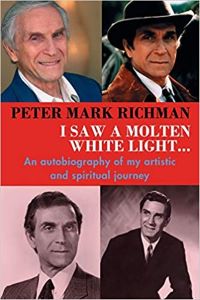 2018, a small publishing house that specializes in the histories of people from classic media and stage published his autobiography. The title, I Saw a Molten White Light, refers to an indelible experience at the age of six that influenced the rest of his life.
2018, a small publishing house that specializes in the histories of people from classic media and stage published his autobiography. The title, I Saw a Molten White Light, refers to an indelible experience at the age of six that influenced the rest of his life.
Peter Mark related to me that he played football in his youth, engaged in theatre in Philadelphia, and managed a drugstore in Rosemont, Pennsylvania when he got out of college. (He had, in fact, become a pharmacist, licensed in two states!) Through the maneuverings of a set designer he knew from Philly, Richman was offered a summer stock acting job in an Equity company at $35 a week. Without hesitation, he quit his pharmacy job – where he had been receiving $125 for a mere four days of work a week – and fled off to be, “a second leading man.” There he met Helen who was a “leading lady” in the stock company. “In three weeks, the leading man got fired,” he says, his voice filled with a smile, “and I became the leading man. I married [Helen] a year later.”
He studied to develop his artistry for stage, film, and TV. From private classes with legendary Method acting coach Lee Strasberg, the Richmans joined the Actors Studio in 1954. Peter Mark (billed as Mark) had racked up a lot of credits in television by the time he appeared in his first film, Friendly Persuasion in 1956 – the classic about a gentle Quaker family challenged by the demands of the Civil War. That same year, he appeared on Broadway in the short Plymouth Theatre segment of the run of A Hat Full of Rain. He worked over 400 performances Off-Broadway in playwright Edward Albee’s famed one-act Zoo Story, starting in 1960. He left early in 1961 to make the now all but forgotten film The Murder Men that led to his Cain’s Hundred TV series. (Imagine the coast to coast commuting necessary to accomplish all of that.)
But he did not enjoy the specialized parameters of the art of doing continuing daytime drama. Richman had a run on the primetime soap opera Dynasty from 1981 to 1984 but he lost patience with daytime’s Santa Barbara and left the afternoon soap after only three months. “You wait around for activity and it’s maddening,” he complains. “It’s like doing summer stock and you’re not well rehearsed.”
* * *
Known not only for his acting, Peter Mark Richman is also lauded as an accomplished playwright, as a novelist, as an award-winning humanitarian, and as a figurative painter. “I was a painter before I was an
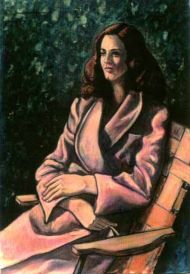
actor,” he says, which takes him back to childhood. “My sister was a wonderful,” he pauses, “ill girl. She had tuberculosis…I was 13 or 14 when she passed.” Gertrude was more than a decade older than young Marvin. “My father had put her up in a little hosiery shop with her husband,” he reminisces, and she would give her young brother some of the papers meant to separate the stockings because she knew he loved to use them for sketching. “She was encouraging,” he says, and it is a quiet lamentation with an audible intake of breath when he utters that he misses her still. Paintings from Richman’s adulthood can be found in collections around the world though they are exhibited primarily in California and gave rise to the “My Nudes at the Playboy Club” chapter in his autobiography.
Also on the literary scene, Hollander’s Deal is Richman’s showbiz novel, and The Rebirth of Ira Masters is the published collection of his short stories.
When Richman spoke of becoming, “opened to the contact,” the reference was to his and Helen’s embracing of Subud, an international spiritual movement founded in the 1920s and active today. It is through Subud that he found an explanation for witnessing the mesmerizing white light that hovered for him alone as he sat on a porch with family members on a summer evening when he was six years old; and his opening in Subud is the source of the affixing of “Peter” to his name. It is no surprise that the Motion Picture and Television Fund awarded this spiritual man the Silver Medallion for outstanding humanitarian achievement; his humanitarianism is always apparent. It is in his playwriting in his witty comedy

A Medal for Murray which received rave reviews during its over two-year run (beginning July 2013) in Israel. It is in his stage play turned screenplay 4 Faces (2001), a tour de force in which he portrays four diversified characters; and in his choice of material such as the haunting short feature The Desperate (2010) in which he takes on the role of a dignified concentration camp prisoner forced to make a decision.
For reasons I, myself, do not fully understand, I did not write his profile until five years after the interview, and was ultimately prompted by his passing. When I had questioned him about the source of his prolificacy he had answered, “I thank God for my blessings;” it is an inclination, he mused, that he and Helen had always tried to instill in their children and grandchildren. “Everything inspires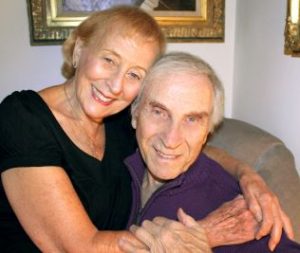
me,” he said. Then, seeming to rummage through his thoughts to come up with something more complex, he concluded with, “and I’ve lived my life and I’ve had a hell-of-a-life,” ending on an upsweep of intonation that implied that it is a simple truth and probably could not have been any other way. ~FW
<- Return to search